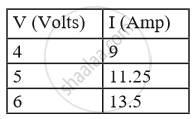Advertisements
Advertisements
प्रश्न
How much work is done in moving a charge of 2 C across two points having a potential difference of 12 V?
उत्तर
The amount of charge, Q that flows between two points at a potential difference, V (= 12 V) is 2 C.
Therefore, the amount of work done, W in moving the charge is given by:
W = V × Q
= 12 V × 2 C
= 24 J
APPEARS IN
संबंधित प्रश्न
State two causes of energy loss in a transformer.
The values of current (I) flowing through a given resistor of resistance (R), for the corresponding values of potential difference (V) across the resistor are as given below:
| V (volts) | 0.5 | 1.0 | 1.5 | 2.0 | 2.5 | 3.0 | 4.0 | 5.0 |
| I (amperes) | 0.1 | 0.2 | 0.3 | 0.4 | 0.5 | 0.6 | 0.8 | 1.0 |
Plot a graph between current (I) and potential difference (V) and determine the resistance (R) of the resistor.
How much work is done when one coulomb charge moves against a potential difference of 1 volt?
State whether a voltmeter has a high resistance of a low resistance. Give reason for your answer.
What current will be taken by a 920 W appliance if the supply voltage is 230 V?
Explain the statement ‘the potential difference between two points is 1 volt’.
The following table shows current in Amperes and potential difference in Volts.
What will be the nature of the graph between the current and potential difference? (Do not draw a graph.)

Explain why potential difference is always less than the e.m.f. of a cell?
A 10 m long wire of a particular material is of resistance 5Ω What will be the resistance of 10m long wire of the same material but the double radius.
Electric potential is a ____________.
